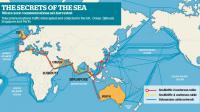The nation's electronic espionage agency, the Australian Signals Directorate, is in a partnership with British, American and Singaporean intelligence agencies to tap undersea fibre optic telecommunications cables that link Asia, the Middle East and Europe and carry much of Australia's international phone and internet traffic.
Secret information disclosed by United States intelligence whistleblower Edward Snowden has revealed that the British Government Communications Headquarters is collecting all data transmitted to and from the United Kingdom and Northern Europe via the SEA-ME-WE-3 cable that runs from Japan, via Singapore, Djibouti, Suez and the Straits of Gibraltar to Northern Germany.
Australia is connected to SEA-ME-WE-3 by a link from Singapore to Perth, and GCHQ's bulk interception includes much of Australia's telecommunications and internet traffic with Europe.
Australian intelligence sources have also told Fairfax Media that Singaporean intelligence co-operates with Australia in accessing and sharing communications carried by the SEA-ME-WE-3 cable which lands at Tuas on the western side of Singapore Island.
Access to this major international telecommunications channel via Singapore's government-owned operator SingTel and the country's Defence Ministry has been a key element in an expansion of Australian-Singaporean intelligence and defence ties over the past 15 years.
It also underpinned the former Howard government's approval of SingTel's takeover of Australia's second largest telecommunications company, Optus, in 2001.
Commissioned in 2000, the 39,000 kilometre long SEA-ME-WE-3 cable is owned by an international consortium that includes British Telecom, SingTel Optus, Telstra and other telecommunications companies across Asia, the Middle East and Europe.
Telstra has an 80 per cent stake in the southern segment that covers the 5000 kilometres between Singapore and Western Australia.
The Australian Signals Directorate also accesses the SEA-ME-WE-3 cable traffic from the cable's landing in Perth.
Australian intelligence expert and Australian National University professor Des Ball said that intelligence collection from fibre optic cables had become "extremely important" since the late 1990s because such communications channels now carry more than 95 per cent of long distance international telecommunications traffic.
"Fibre optic cables are much more difficult to intercept than satellite communications," Professor Ball said. Australia's undersea cable links carry both international and domestic traffic because internal Australian communications are often routed overseas depending on traffic loads.
One former Australian Defence intelligence officer told Fairfax Media that access to submarine fibre optic cable traffic ''gives the 5-eyes [intelligence alliance] and our partners like Singapore a stranglehold on communications across the Eastern Hemisphere''.
In June The Guardian newspaper published details from top secret documents leaked by Mr Snowden of a major GCHQ interception program, codenamed Tempora, that involves harvesting all data, emails sent and received, instant messages, calls, passwords and more, entering and exiting Britain via undersea fibre-optic cables.
Details of telecommunications companies including British Telecom, Verizon Business sand Vodafone Cable involved in the British interception program were subsequently published by German newspaper Sü¨ddeutsche Zeitung which also gained access to some of Mr Snowden's information.
Further information obtained via Sü¨ddeutsche Zeitung has now confirmed that the SEA-ME-WE-3 is one of the most important undersea cables accessed by GCHQ and the US National Security Agency.
Australian intelligence sources have separately confirmed that the Australian Signals Directorate and the highly secretive Security and Intelligence Division of Singapore's Ministry of Defence also play key roles in intercepting communications traffic through Asia.
Professor Ball says the Australian Signals Directorate has a long history of co-operation with Singapore which has "probably the most advanced" signals intelligence capabilities in South East Asia.
Significantly SingTel also has close relations with Singapore's intelligence agencies. In August 2001, the former Howard government approved SingTel's $17 billion takeover bid for Optus in a deal that raised widespread comment on security and privacy issues.
Then Treasurer Peter Costello said the deal was in Australia's national interest after SingTel entered into deeds of agreement with the Defence Department and ASIO.
These agreements dealt with the security of Australian telecommunications systems and the operation of interception facilities for ASIO and Australian law enforcement agencies. Mr Costello said that Australian national security interests were protected and that "full privacy laws in Australia [would] apply" to Australians' phone calls and internet communication.
However, former Australian Defence intelligence officers said the Howard government's approval of SingTel's purchase of Optus also took into account growing Singaporean-Australian intelligence co-operation which in turn rested on Singapore's access to the SEA-MEA-WE-3 cable, as well as the later SEA-ME-WE-4 cable from Singapore to the south of France.
The office of former prime minister John Howard did not respond to a request for comment.

